Representing royal bodies has, since the seminal and formative example of the church of the Virgin Evergetis in the monastery of Studenica, the endowment of Stefan Nemanja, subsequently monk Simeon, and his son Stefan Prvovenčani, the first-crowned king of Serbia, been an axial and defining component of communicating ideas of royal identity, legitimacy of the line of succession on the throne, and a staple element of the painted programs of royal endowments, mausolea in particular. In Studenica, an image of the founder of the Nemanjić dynasty, which ruled over Serbian lands from the 12th do the close of the 14th century, stands as part of the ktetor’s composition painted originally in fresco in 1208-1209 by some of the most outstanding artists of the day of probable Constantinopolitan origin and repainted in the 1568. Holy Simeon Nemanja died in the Serbian monastery of Chilandar on Mount Athos in 1199. His body was transferred to Studenica in 1207 by his youngest son, Rastko, Saint Sava the Serbian, founder and first bishop of the autocephalous Serbian Orthodox Church in a procession which the Serbian medieval sources likened to the transfer of the Ark by King David to Jerusalem (Erdeljan 2013; Cvetković 2022, 178). In Studenica, Nemanja is depicted above his second tomb and final resting place. In the present, 16th century version of the fresco, he is shown as both ruler and monk. He wears a cupola-shaped crown and a monastic cloak and holds a model of the church while being led by the Virgin to the throne of Christ who gives him his blessing [Fig. 1]. Originally, the early 13th century ktetor’s composition painted in 1208-1209 probably included the portraits of Nemanja’s two sons, Vukan and Stefan. This could have been a striking visual signum of regained dynastic unity achieved through the reconciliation of Nemanja’s two heirs and pretenders to the throne that had been negotiated by their youngest brother, Rastko Sava, literally over the body of their father (Todić 1997, 38).
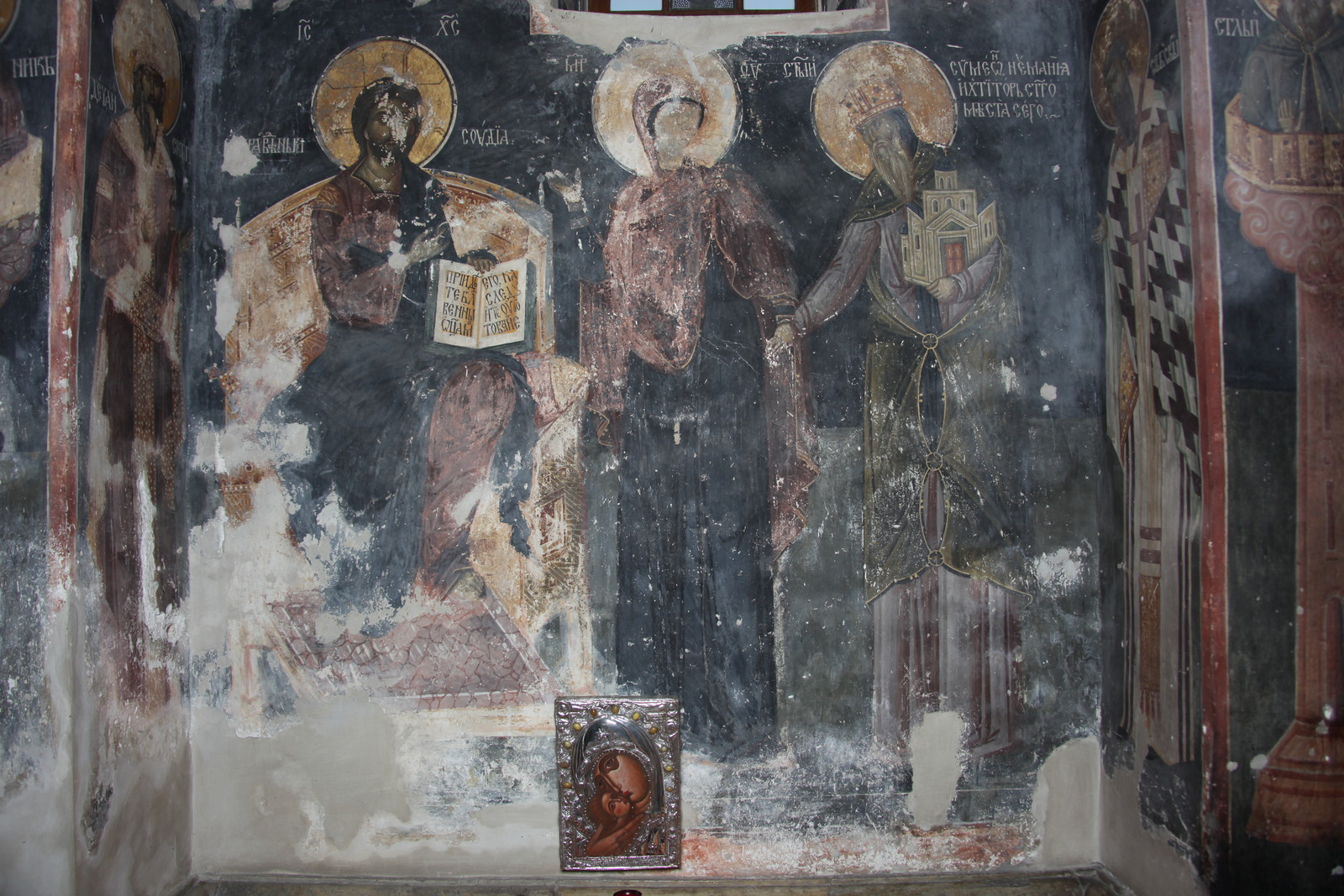
1| Studenica. Ktetor’s portrait of Saint Simeon Nemanja (Blago Fund).
Although the early 13th century image was repainted in the second half of the 16th century, it most certainly repeated the original in choice of figures and their arrangement, possibly also the iconography of the ktetor as both ruler and monk. In the vita text composed by his son, Rastko, Saint Sava the Serbian, as part of the introduction to the typikon of Studenica, Nemanja is directly referred to as both ruler and instructor of the True Faith (St. Sava 1928, 152). This double identity, apart from the symbolism of the number two which is a recurrent topos in his vita – two christenings, two monastic wows, two graves (St. Sava 1928, 173–174; Stanković 2022, 394), would also underline and drive home most directly the expressedly eschatological (visual) message of ktetors’ portraits in general and more specifically of that of Nemanja. The double identity of Nemanja as both ruler and monk, i.e. instructor of True Faith in his funerary and ktetor’s portrait, is complemented or mirrored in the rhetoric and topos of terrestrial angel and celestial man, as Nemanja is referred to in the encomium composed by his son, Saint Sava the Serbian, in his vita (St. Sava 1928, 152). His image painted above his grave is thus a means of visual rhetoric communicating both, nominally contrasting, conventions of encomium in Byzantine imperial art that have their counterparts in court panegyrics. The first is a metaphorical visualization of the emperor as a garden of the graces and the second praises the emperor as a diagram of supernatural qualities (Maguire 1989, 217).
Holy Simeon Nemanja is a myroblyte saint whose cult is in many ways similar to that of the myrrh-pouring Saint Demetrios of Thessalonike. What is more, it was not only Nemanja’s royal body that was the source of the pouring of myrrh, which began exuding already from his first, Athonite tomb in the monastery of Chilandar. The blessed and sacred fluid also flowed directly from his image painted above his second, Studenica tomb (Todić 1997, 40). Thus, from the very beginning, in the Serbian milieu the (painted) image of the royal body is doubly significant – as the most visible and accessible means of staging of the immutable Body politic of the king, to use Kantorowicz’s terminology, and as a relic itself, a medium of agency or performance of Divine Providence in the overall hierotopy of the sacral space of the church and the land which, through the presence and agency of the holy body and its image (icon), is thus transformed into a spatial icon of New Jerusalem (Erdeljan 2014).
The iconographic and compositional formula – painted above the sarcophagus marking the grave of Stefan Nemanja, i.e. Saint Simeon as the founder of the dynasty in his endowment, seen as the Tower of True Faith and a reliquary of the True Cross housing particles of the Life-Giving Tree that had originally been embedded in his personal pectoral, one which, following the translatio of his relics, became the center of pilgrimage and veneration of both the True Cross and the Nemanjić dynastic cult (Erdeljan 2011, 98; Erdeljan 2016) – is repeated in (funerary) churches raised subsequently by his royal descendants. It is adapted in accordance with historical and political realities and programs and visually reworked with a gradual extension and enlargement, including an increasing number of bodies of royal personae from the Nemanjić family in what is known as the horizontal genealogy of the Nemanjić family (Cvetković 2022, 179). Following the model of the founder of the dynasty, other kings among his progeny also became saints, and thus the Nemanjić family tree became a de facto holy tree.
Roots of this concept run deep and were already planted in Studenica, where the narrative of the Life-Giving tree in all the stages of its transformation – from its inception in Paradise to the revelation of its true nature as the vexillum of Christ’s triumph and herald of eschatological Paradise (re)gained through the Crucifixion – are most directly entwined with the royal and saintly narrative of Nemanja-St. Simeon. In Studenica, the True Cross, like Nemanja himself as one placed under its protection, is venerated through both the actual presence of the relic as well as through the vicarious agency of related and multiply present imagery crowned by the Crucifixion as the ultimate image of triumph. This is most spectacularly visible through the image of the majestic and grand scene of the Crucifixion, which dominates the entire space of the church of the Virgin in Studenica as it covers the entire western wall of its naos (Fig. 2 Studenica, Crucifixion), rising and towering directly over the tomb of Nemanja who rests, literally, at its foot. His two holy bodies, the relics laid in his tomb and the image painted above it, present in the church of the Virgin Evergetis, which he raised at the close of the 12th century, are thus virtually experienced as the new cosmic mound from which the rivers of Paradise flow (Erdeljan 2011, 98; Erdeljan 2016, 82).
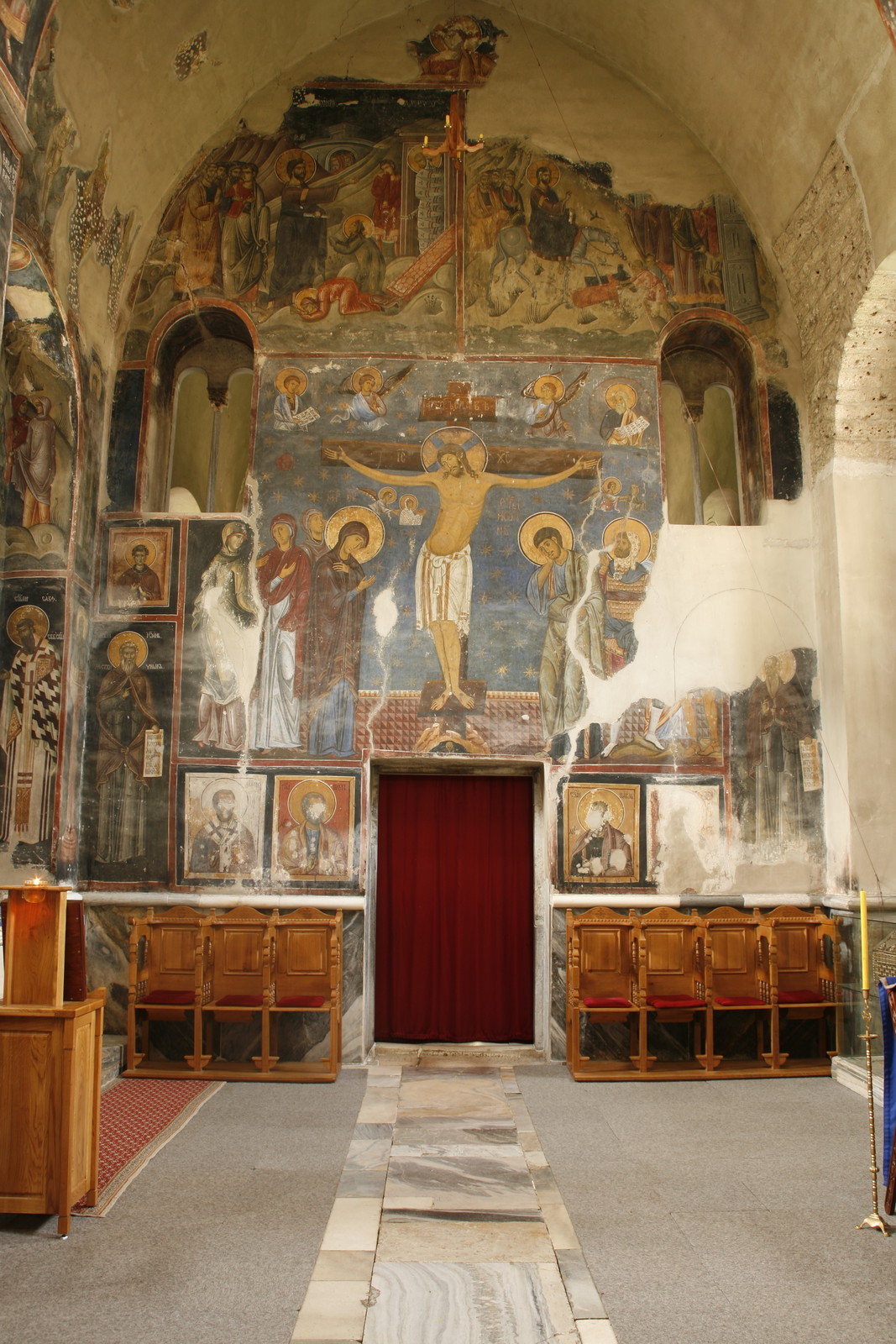
2| Studenica. Crucifixion (Blago Fund).
Horizontal genealogies of the Nemajić holy family (dynastic) tree appear in churches raised by his heirs in the 13th and the 14th century in a number of compositional variations, as both funerary and simply ktetors’ portraits. They are preserved in monastery katholikon churches of Mileševa, Sopoćani, Gradac, Arilje, the funerary chapel of king Dragutin in the monastery of Đurđevi Stupovi, and in the church of the Virgin Ljeviška Eleusa, the cathedral church of the city of Prizren (Cvetković 2012). Among them, the church of the Ascension of the Lord in the monastery of Mileševa, endowment and mausoleum of King Vladislav (1234-1243), son of Nemanja’s son and heir, Stefan Prvovenčani, offers the first preserved and one of the most significant such examples executed in mimesis of the Studenica prototype. The ktetor’s composition proper stands on the south wall of the naos, directly above the sarcophagus marking the tomb of king Vladislav positioned like that of his grandfather, Stefan Nemanja, in Studenica in the southwest corner of the naos (Fig. 3 Mileševa. Tomb and ktetor’s portrait of King Vladislav). Painted against a gold background with imitation of mosaic tesserae, the king, bearing a model of his church, is led by the Virgin towards the throne of Christ. Right above the ktetor’s composition, on the same wall and in the same spot as in the original 13th century program of decoration of Studenica, we find the eschatologically intoned representation of the Resurrection of Christ in the iconographical form of the Myrrh-bearing Women at the Tomb. Other members of the Nemajić dynasty, the ktetor’s (holy) ancestors and predecessors on the throne are portrayed in the form of a horizontal genealogy, a long row of standing figures of exceptional portraits positioned on the north and east wall of the original narthex of the church (Cvetković 2012, 161; Cvetković 2022, 186) (Fig. 4 Mileševa. Horizontal genealogy of the Nemanjić family in the nartex).
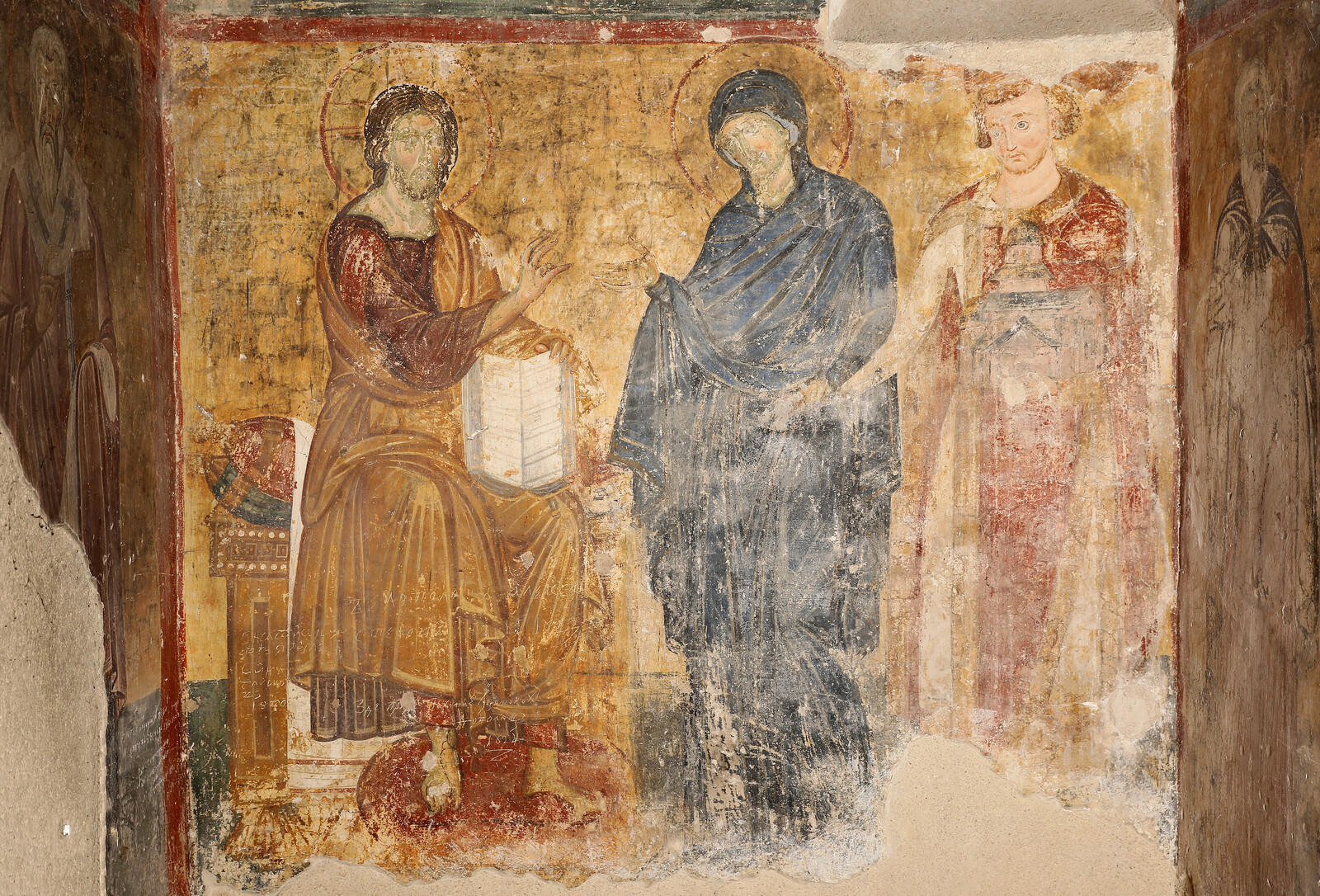
3| Mileševa. Ktetor’s portrait of King Vladislav (Blago Fund).
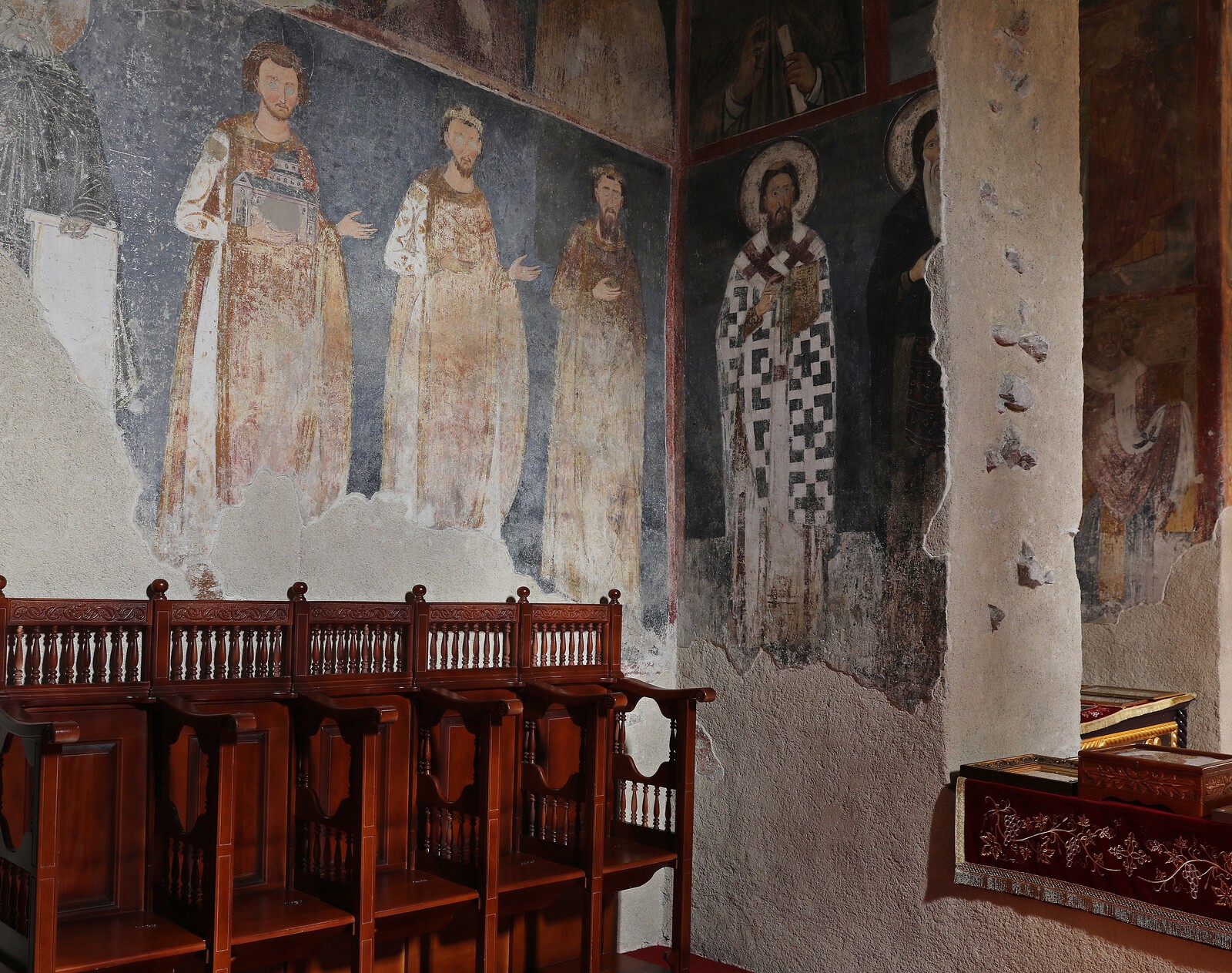
4| Mileševa. Horizontal genealogy of the Nemanjić family in the narthex (Blago Fund).
With the construction of the vast exonarthex, which was to become the final resting place where the body of Saint Sava, uncle of king Vladislav, was transferred from his first tomb in the basilica of the Forty Martyrs in Tarnovo, the capital of the Second Bulgarian Empire, the original narthex was integrated into the unified space of the church by tearing down most of the wall that divided the naos from the narthex in the beginning. As a result, the figure of Saint Simeon Nemanja, leading the line of the horizontal genealogy of the Nemanjić family in Mileševa is literally split in half vertically. Following him, and right next to him in the northeast corner, on the now half torn east wall of the original narthex is the portrait of Saint Sava with the line of Nemanjić rulers extending along the north wall of the original narthex towards the west, with standing figures of Kings Stefan Provenčani, son of Stefan Nemanja, and his two sons, kings Radoslav (1221-1234) and, once more, Vladislav carrying a model of his church (Cvetković 2012, 161).
On the opposite, south wall of the same spatial unit of the church of the Ascension in Mileševa (the original narthex), we see the first integration and sole existing example on the soil of the Serbian Nemanjić state proper – notwithstanding the 14th century example of the katholikon of Chilandar monastery on Mount Athos, where King Milutin is portrayed together with the emperor of the Romans and his father-in-law Andronicos II – of a portrait of an emperor of the Romans as part of the broader iconographic and programmatic scheme of the genealogy of Serbian Nemanjić rulers. In Mileševa, Alexios III Angelos, whose daughter Eudokia was married to the son of Stefan Nemanja, Stefan Prvovenčani, is portrayed on the south wall, opposite the figure of his son-in-law (Cvetković 2022, 177) (Fig. 5 Mileševa. Portrait of emperor Alexios III Angelos in the narthex). He is the maternal grandfather of the two elder sons of Stefan Prvovenčani, Kings Radoslav and Vladislav, the ktetor of Mileševa. The political, diplomatic and ideological implications of this narrative are quite obvious as they underline the de facto imperial sanctioning and legitimacy of the line of succession on the Nemanjić throne. The significance of this visual narrative, however, is more complex.
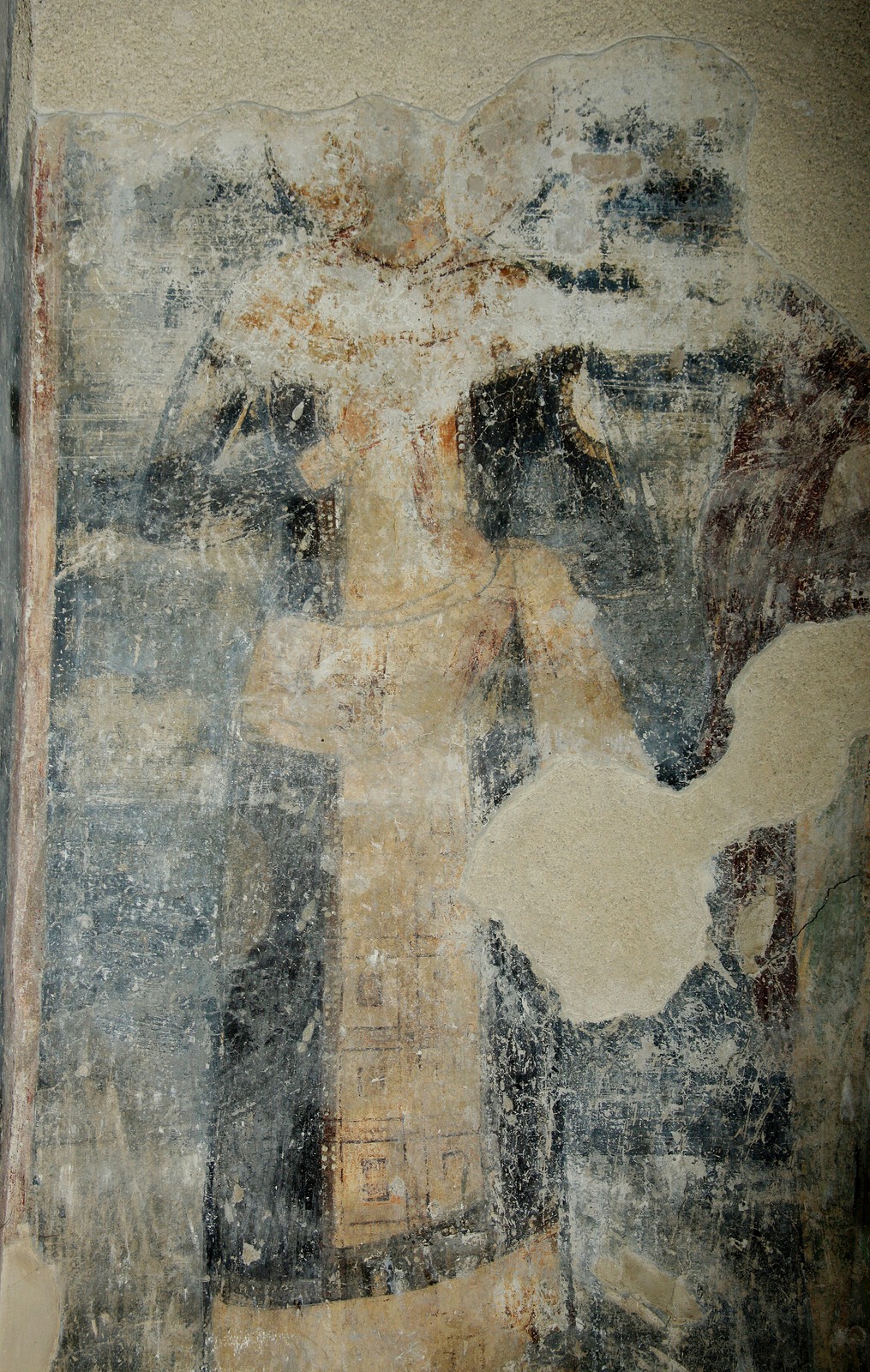
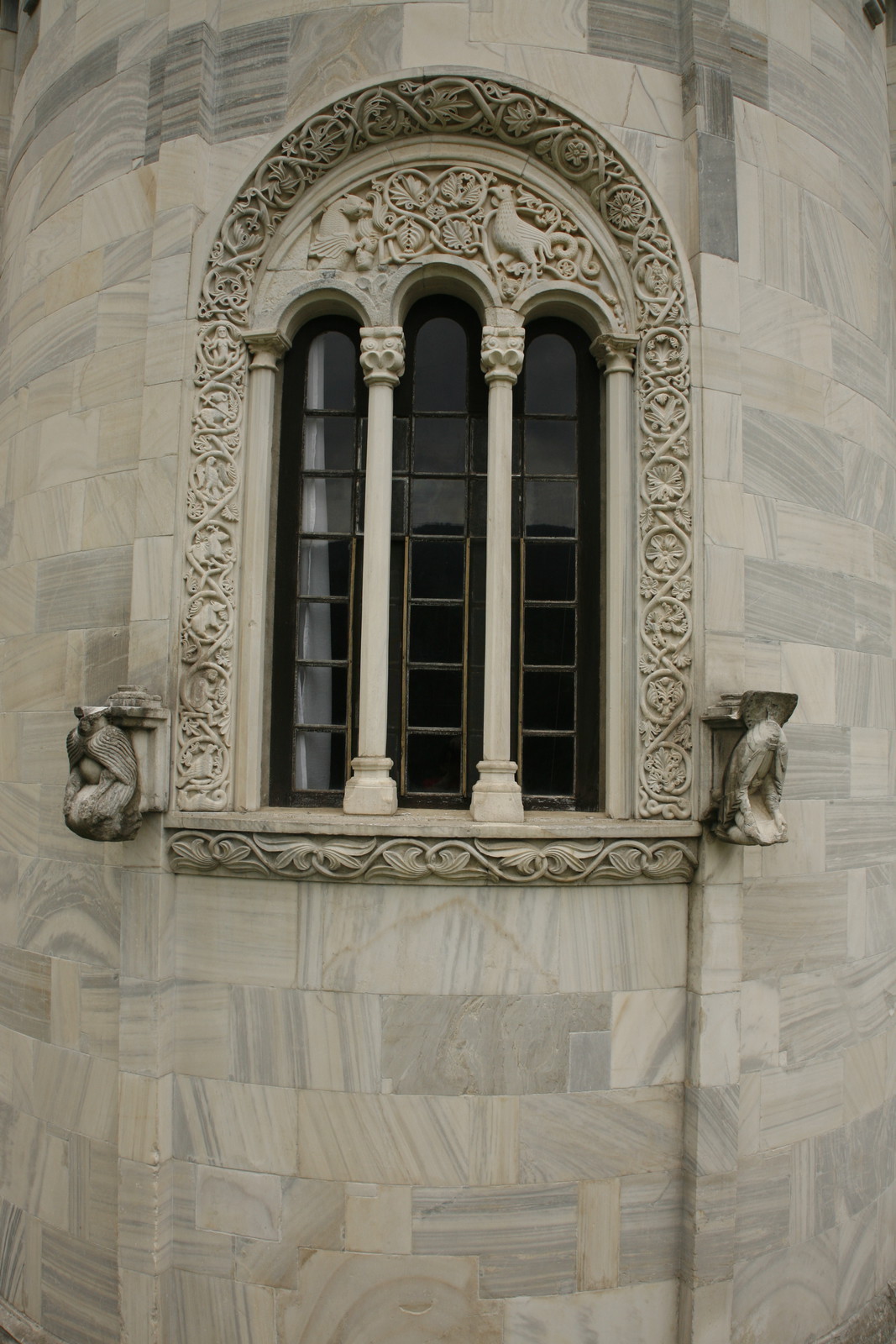
5| Mileševa. Portrait of Emperor Alexios III Angelos in the narthex (Blago Fund).
6| Studenica. Tripartite window of the main altar apse (Blago Fund).
Henry Maguire has long pointed out that rhetoric was an important component which affected the literature, art, and even the mentality of the Romaioi (Maguire 1988, 88). It is precisely rhetoric that points to a higher level of content of such a visual ordering of the horizontal genealogy of the Nemanjić holy family tree in Mileševa. This is an exceptional example of a highly learned use of the rhetorical form of juxtaposition for the purpose of synkrisis as a medium of visual encomium of the ruling Serbian dynasty. By placing the figure of the first-crowned Serbian king from the Nemanjić dynasty, Stefan Nemanjić, directly opposite the figure of the basileos ton Romaion, Alexios III Angelos, synkrisis is achieved with the mystical body of the emperor, so highly extolled in encomia and court panegyrics of the Komnenian and, in particular, the age of the Angeloi, with the emperor being likened to the angels (Maguire 1989, 223). As has already been pointed out, the same type of comparison of Serbian rulers with higher celestial beings has been present in Serbian hagiography since the days of Stefan Nemanja. In fact, it is possible that the two kneeling and thus far unidentified figures on either side of the monumental tripartite window on the façade of the altar apse of the church of the Virigin Evergetis in Studenica (Fig. 6 Studenica). Tripartite window of the main altar apse) could actually be interpreted as representations of the two royal bodies of Nemanja – terrestrial angel and celestial man.
A similar ordering of the narrative of the genealogy of the holy Nemanjić family tree was employed in the cathedral church of the ancient city of Prizren, the church of the Virgin Eleusa or Ljeviška. In the first decade of the 14th century, in 1306-1307, king Milutin, great-grandson of Stefan Nemanja, restored and built anew the ancient Byzantine cathedral, the oldest strata of which go back to Justinianic times. Prior to the 14th century, the church of the Virgin Ljeviška had been already renovated in the Middle Byzantine period (9th to 11th centuries), as well as during the rule of Serbian Nemanjić kings over the ancient city of Prizren, situated on the Bistrica River, a strategically significant town, well-connected by trade routes and major Balkan thoroughfares spanning its territories from the Limes to the Adriatic Sea and connecting them with cities such as Thessalonike and Constantinople (Panić, Babić 2007, 10-13, 28-40). Members of the ruling Nemanjić family are depicted on the western and the eastern wall of the inner narthex, in this case without any funerary implication (Todić 1999, 48, 52-55). They stand as a political and ideological statement regarding the holy root and blessed provenance of the entire Nemanjić family and King Milutin in particular. This message is communicated through verbal and visual synkrisis with the emperor(s) of Rome, but also with their mystical body, i.e with the messianic, Davidic nature of the emperor and the tree of Christ whom he represents on Earth. They are ordered around the main west-east axis of the overall sacral space of the cathedral, around (and above) the doorways leading from the exonarthex into the narthex and from there into the complex space of the five-domed naos constructed under the ktetorship of king Milutin and two Serbian bishops of Prizeren, Damjan and Sava. That axis of growing sacrality leading directly to the main altar apse of the church, is marked by representations of two axial, juxtaposed, and thus likened figures.
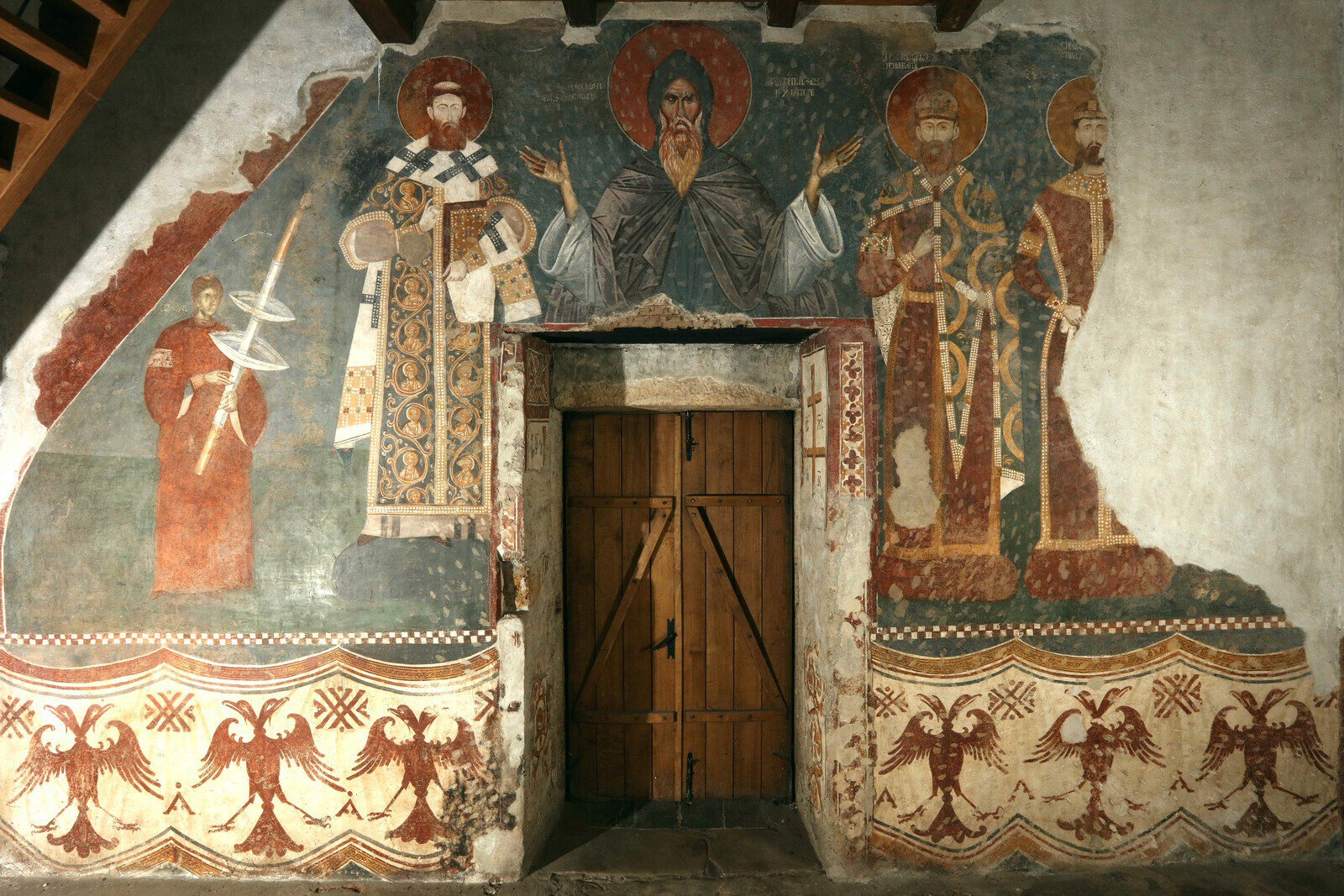
7 | Prizren. Western wall of the narthex of the church of the Virgin Ljeviška (Blago Fund).
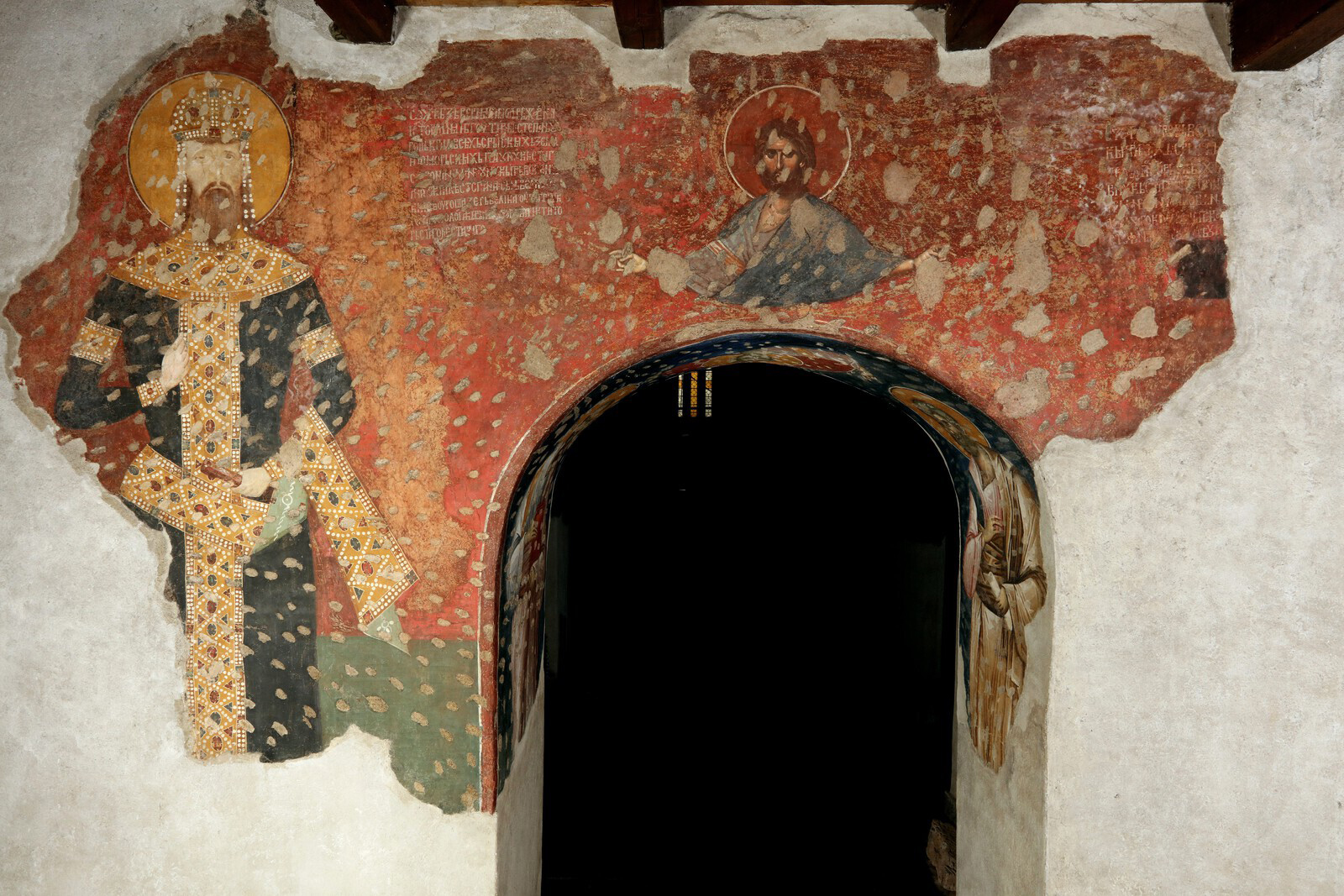
8 | Prizren. Eastern wall of the narthex of the church of the Virgin Ljeviška (Blago Fund).
On the western wall of the narthex, directly above the doorway, is a half-figure of Saint Simeon Nemanja. He is represented in monastic clothes, his hands raised in prayer, blessing his two sons whose full figures appear on either side of the doorway (Fig. 7 Prizren. Western wall of the narthex of the church of the Virgin Ljeviška). On the north side of that doorway and the half-figure of Simeon Nemanja stands Stefan Prvovenčani, while the opposite, south side of that part of the western wall of the narthex is given to Saint Sava the Serbian. Further down the western wall, towards the north, are figures of two archbishops of the Serbian Orthodox Church from the Nemanjić family. Mirroring the core of this specific rendering of the horizontal genealogy of the Nemanjić family, and as its integral part, we find the following representations. On the eastern wall of the narthex, directly above the doorway leading from the inner narthex into the naos, and further east, to the altar apse, is a half-figure of Christ Pantokrator blessing the figures of the son and grandson of the first-crowned Serbian king and the grandson and great-grandson of the founder of the state, the root of the holy Nemanjić family tree, Saint Simeon Nemanja (Fig. 8 Prizren. Eastern wall of the narthex of the church of the Virgin Ljeviška). Painted on the eastern wall of the inner narthex against a unique red background and accompanied by an extensive inscription, to the north of Christ stands a monumental figure of king Stefan Uroš II Milutin (Fig. 9 Prizren. Portrait of king Milutin in the church of the Virgin Ljeviška), while that of his father Stefan Uroš I, now lost except for the accompanying inscription, is positioned on the south side of the mentioned passage (Todić 1999, 48).
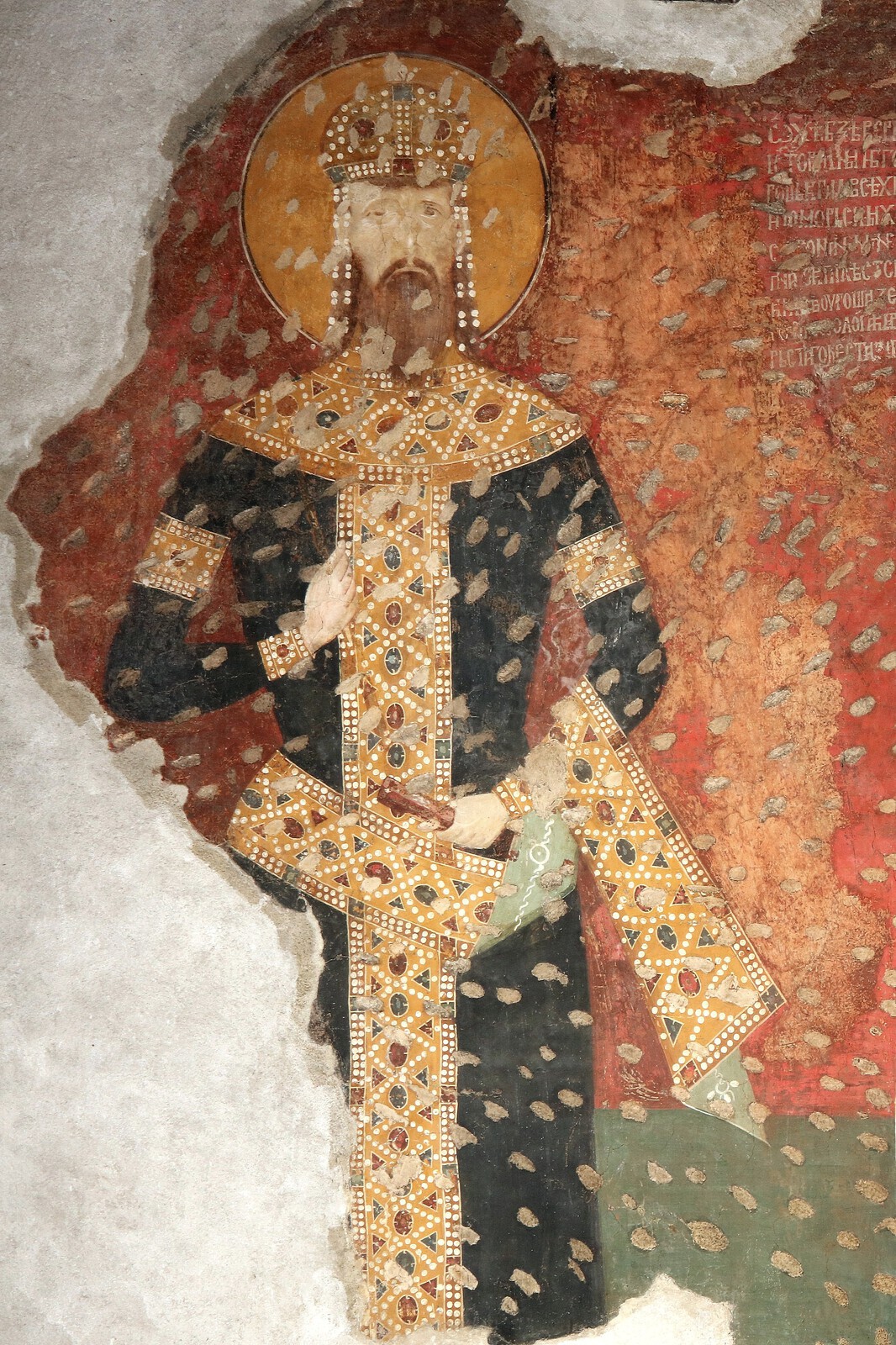
9 | Prizren. Portrait of King Milutin in the church of the Virgin Ljeviška (Blago Fund).
The visual rhetoric of the entire space relies on juxtaposition and thus synkresis of the half figures of Christ and that of Simeon Nemanja. Nemanja is thus presented as an icon of Christ the Door (“I am the door. If anyone enters by Me, he will be saved, and will go in and out and find pasture”, John 10:9) and his descendants as fruit of the blessed holy family tree. Christ is depicted in the act of blessing the ruler and ktetor of the church of the Virgiin in Prizren, King Milutin, dressed in full imperial costume, one who had entered into unity with the kingdom of the basileos ton Romaion in the Spring of 1299, through his marriage to the daughter of emperor Andronicos II Palaiologos, Simonis (Stanković 2013, 59, 63). His father, king Stefan Uroš I, whose figure is now vanished, receives the same outpouring of divine grace through the blessing of Christ. Both Uroš I and Milutin had appeared in full imperial garb, including a cupola-shaped crown, prependulia and loros already a full forty years earlier, in the narthex of king Uroš’s own mausoleum, the church of the Holy Trinity in Sopoćani (Cvetković 2012, 167). At the time a marriage had first been planned between a scion of Saint Simeon Nemanja, the young prince Milutin, and a princess of the imperial Palaiologos family born in purple, Anna, daughter of emperor Michael VIII Palaiologos (Stanković 2013, 58). Those plans never came to fruition, but we must note that all members of king Uroš’s family did appear in full imperial costume on their fresco portraits painted in the narthex of the church of the Holy Trinity in Sopoćani. What is more, the portrait of then-prince Milutin accompanied by his mother, Queen Helen, is positioned directly under the fresco depicting the Tree of Jesse (Cvetković 2012, 168) (Fig. 10 Sopoćani. Portrait of Prince Milutin and Queen Helen in the narthex).
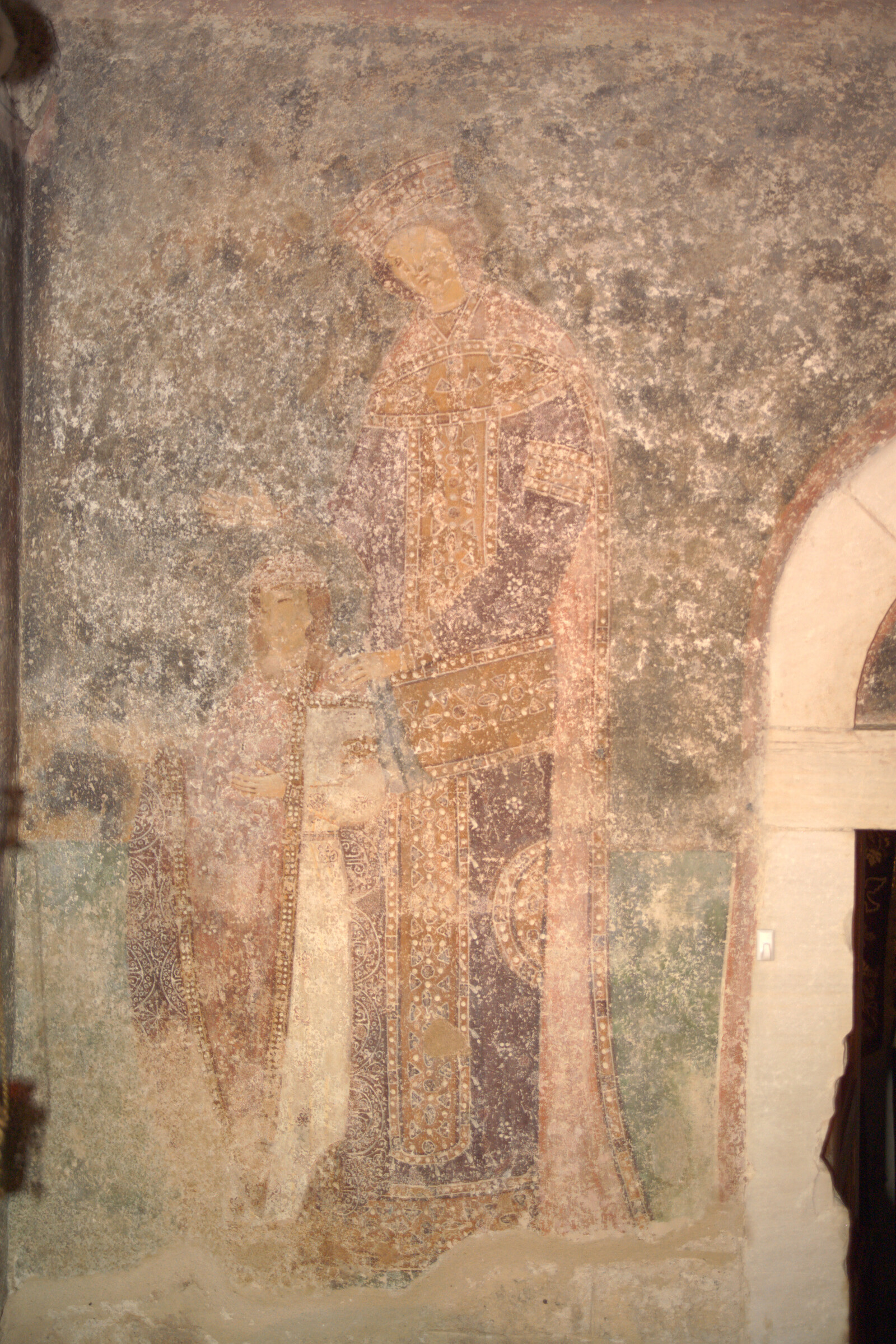
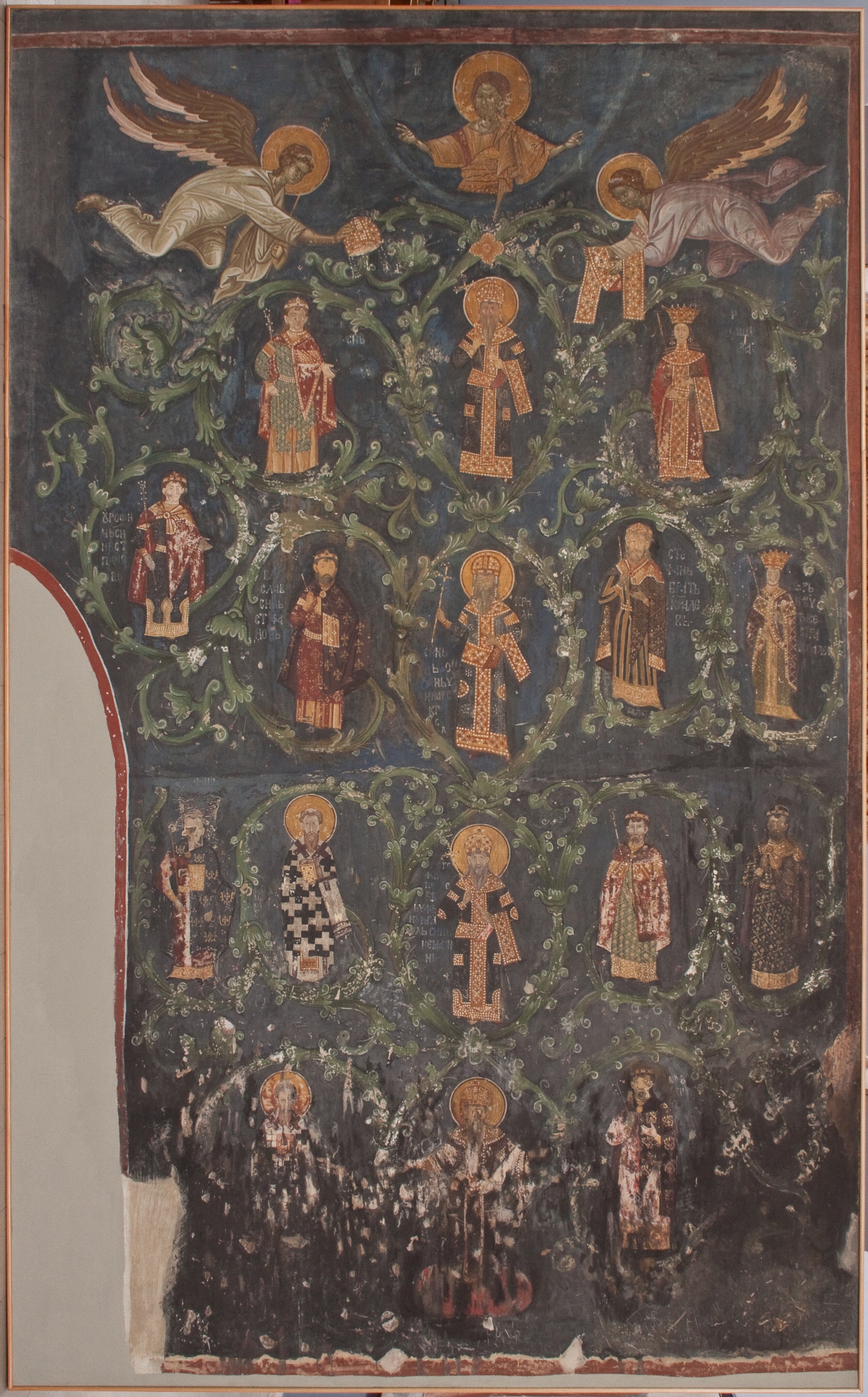
10 | Sopoćani. Portrait of Prince Milutin and Queen Helen in the narthex (Blago Fund).
11| Gračanica. The Nemanjić family tree (Blago Fund).
On the opposite wall, we find an image of Stefan Nemanja, St. Simeon, arms uplifted like a New Moses, blessing his two sons – the first-crowned king of Serbia, Stefan Prvovenčani, and the founder and first archbishop of the autocephalous Serbian Orthodox Church, St. Sava the Serbian. What is more, although clearly representing the line of succession on the Serbian throne, there is a specific spatial relationship and higher level of visual rhetoric between the figure of Stefan Prvovenčani and King Milutin painted directly one opposite the other on the western, i.e. the eastern wall of the narthex. Such a disposition of these two (depicted) royal bodies underlines a direct succession between the two of them – not in a chronological sense since Stefan was, eventually, succeeded on the throne by his son Uroš I, father of king Milutin, but rather in the sense of succession as imperial sons-in-law, as those who had, through marriage, become one with the vine and the fruit of the messianic family tree of the Christian emperor of the Romans. It is important to note that the benevolent diplomatic terms used to describe the Serbs found in the chryssobul issued in January 1299 by emperor Andronicos II Palaiologos confirming the possessions and privileges of the Serbian monastery of Chilandar on Athos can be compared with only two other examples – those found in the charters issued to the same Serbian monastery by the emperor Alexios III Angelos in 1198 and 1199 (Stanković 2013, 62).
The final format of representation of the holy Nemanjić family tree – as we see in the church of the Virgin in the monastery of Gračanica, raised by King Milutin in the last years of his life and reign and decorated with frescoes by the year 1321, immediately prior to the death of the ktetor and king in October of that year – is a logical follow-up of the program of decoration found in the narthex of the church of the Virgin Ljeviška in Prizren. In Gračanica, it took on the scheme of the messianic tree of Jesse, one that bore the Logos Incarnate, the Messiah himself (Fig. 11 Gračanica. The Nemanjić family tree). It was subsequently repeated in Serbian royal endowments until the fall of the Serbian state under Ottoman rule – in the Patriarchate of Peć, the church of the Pantokrator in Dečani, the church of the Virgin in Mateič, and on the outer wall of the entrance tower of the monastery of Studenica (Cvetković 2022, 179-181). In Gračanica. it appeared as the ultimate political statement and testament of the ktetor, King Milutin. Although (and perhaps precisely for that same reason) his marriage to the porphyrogenita remained childless and did not bear fruits that would both be the product of the holy Nemanjić family tree and of the anointed messianic emperor of the Christian Roman Empire, in order to secure the vertical line of succession among his own heirs (Stanković, Erdeljan 2021, 100), Milutin’s royal body was represented twice, perhaps even thrice, on the virtual triumphal arch which leads from the narthex, or rather the ambulatory nave encircling the core of the church, into the nave and towards the altar (Todić 1999, 49-52).
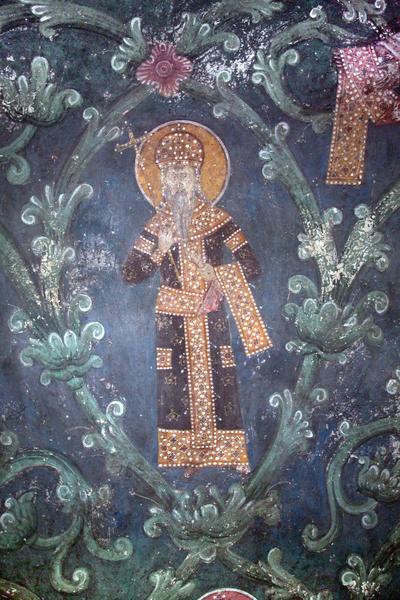
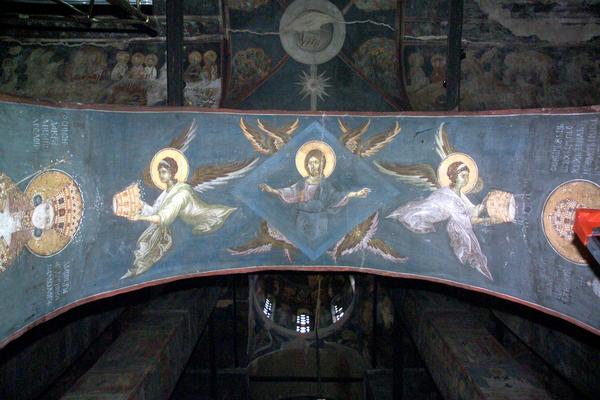
12 | Gračanica. Portrait of King Milutin as part of the Holy Nemanjić Tree (Blago Fund).
13| Gračanica. Heavenly investiture of King Milutin and Queen Simonis (Blago Fund).
This verticality of power, and political succession granted by Christ is presented clearly in the first image of the holy Nemanjić family tree painted as an actual vine, in legitimate synkrisis with the Tree of Jesse (“And there shall come forth a rod out of the stem of Jesse, and a Branch shall grow out of his roots”, Isaiah 11:1) and, indeed of Stefan Nemanja-Saint Simeon as the New Jesse. At the top of this complex composition on the south side of the eastern wall of the narthex of Gračanica – a veritable triumphal arch, as the final fruit of that tree – stands the image of the royal mystical body of King Milutin in full imperial dress and holding a cross shaped scepter, with angels bestowing upon him the insignia of eternal, God granted power: the crown and the loros (Fig. 12 Gračanica. Portrait of King Milutin as part of the Holy Nemanjić Tree). Milutin stands directly below a half figure of Christ blessing. The same motif of celestial investiture also appear on the intrados of the arch opening between the narthex and the naos with representations of king Milutin and queen Simonis, and angels bringing their crowns from the heavens and Christ blessing them (Fig. 13 Gračanica. Celestial investiture of King Milutin and queen Simonis). On the other side of the eastern wall of the narthex, north of this arched doorway, stand two figures under a half-figure of Christ blessing (Fig. 14 Gračanica. Portraits on the northern part of the eastern wall of the narthex). Both are in monastic dress, one female and the other male. Between them are silhouettes of two kneeling male figures painted over in blue, those of King Milutin and his son Konstantin, blended in with the background of the existing fresco representing the two standing figures of the final version of this fresco. The two standing figures are those of Queen Helen, wife, or better widow, of king Uroš I and mother of King Milutin, as nun Helen and the other has been variously identified as either that of King Uroš as a monk or as King Milutin himself (Stanković, Erdeljan 2021,100) . Although Milutin had never taken the monastic wow and entered a monastery, his possible representation as a monk as a visualisation of his repentance in his old age – also indicated aby the text of the chryssobul he issued to the monastery of Gračanica, in which he refers to himself as 'sinful' (Stanković, Erdeljan 2021,100) – could be interpreted as a visual signum of the ideal of akra tapeinosis and Christomimesis and possibly also as his own reference to the two bodies of his celebrated predecessor, the stem from which sprang the rod of the holy Nemanjić family tree, Saint Simeon-Nemanja as terrestrial angel, celestial man.
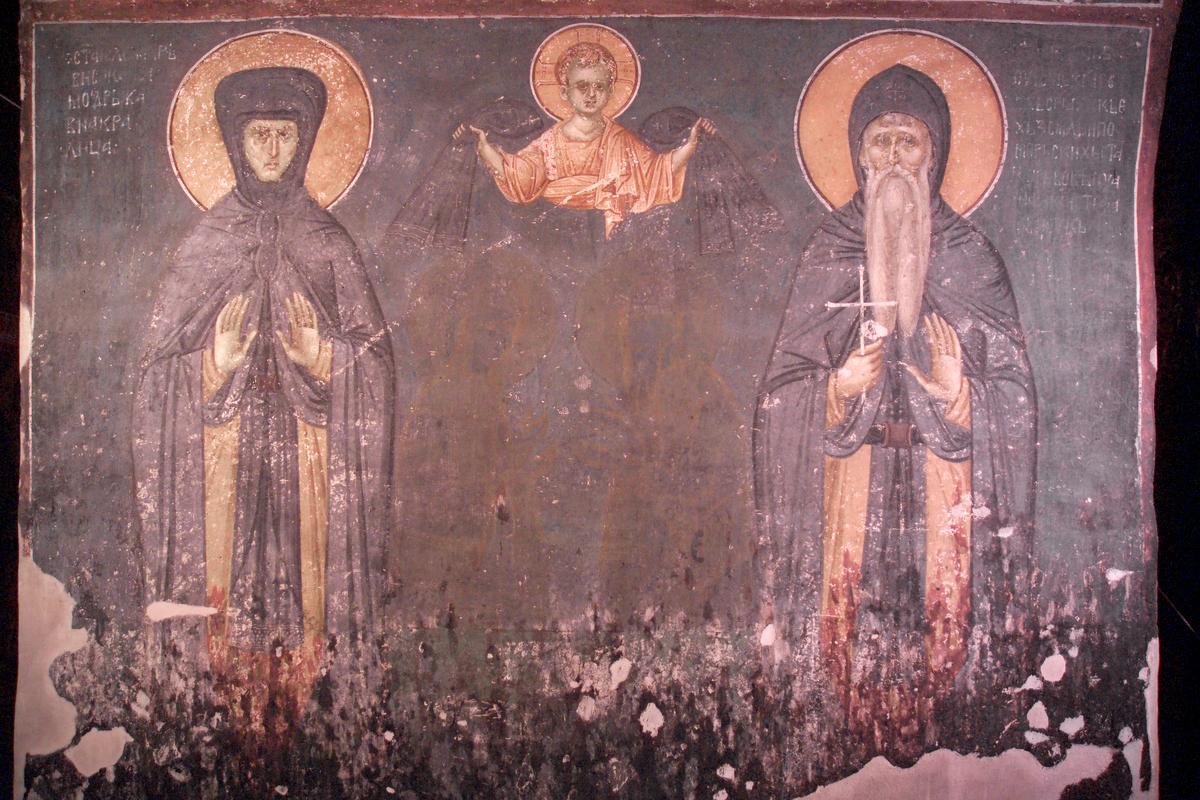
14 | Gračanica. Portraits on the northern part of the eastern wall of the narthex (Blago Fund).
Thus, the evolution of the visual representation of the holy Nemanjić family tree – from the ktetor’s portrait of Simeon Nemanja painted above his tomb in the church of the Virgin in Studenica, associated with a majestic image of the Crucifixion and the presence of a particle of the Life-Giving Tree inside that sacral space, to the form of an actual vine it took in the church of the Virgin in Gračanica, the last endowment of Nemanja’s great-grandson, King Stefan Uroš II Milutin – is that of growing and increasingly palpable visual synkrisis with the life-giving Tree of Jesse, the vine of salvation that produced the Messiah as Logos incarnate. Throughout the stages of its development, the holy Nemanjić family tree was conceived of and instrumentalised as a medium of subtle and deep visual rhetoric referencing topoi and procedures of Byzantine imperial encomia and thus underlining also the political position of the Serbian rulers from the Nemanjić dynasty within the family tree of the basileos ton Romaion, from the late 12th century on. By entering into unity with the family tree of the Christian emperor of the Romans of messianic, Davidic nature, King Milutin was finally able to testify directly of the body of the Serbian king, and the bodies of his holy predecessors, being entwined in the vine of salvation in a most direct manner, by presenting his (holy) family tree in direct mimesis of that of the Tree of Jesse.
References
- Cvetković 2012
B. Cvetković, The Painted Programs in Thirteenth-Century Serbia: Structure, Themes, and Accents, in J.-P. Caillet et F. Joubert, Orient et Occident méditerranéens au XIIIe siècle. Les programmes picturaux, Paris 2012, 157-176. - Cvetković 2022
B. Cvetković, The Royal Imagery of Medieval Serbia, in M. Bacci, M. Studer-Karlen, M. Vagnoni (eds), Meanings and Functions of the Ruler’s Image in the Mediterranean World (11th-15th Centuries), Leiden 2022, 172-218. - Erdeljan 2011
J. Erdeljan, Studenica. An Identity in Marble, “Zograf”, 35 (2011), 93-100. - Erdeljan 2013
J. Erdeljan, Studenica. A New Perspective?, in M. Angar, C. Sode (eds), Serbia and Byzantium. Proceedings of the International Conference Held on 15 December 2008 at the University of Cologne, Frankfurt am Main 2013, 33-43. - Erdeljan 2014
J. Erdeljan, Strategies of Constructing Jerusalem in Medieval Serbia, in B. Kühnel, G. Noga-Banai, H. Vorholt (eds), Visual Constructs of Jerusalem, Turnhout 2014, 231-240. - Erdeljan 2016
J. Erdeljan, Studenica and the Life Giving Tree, in V. Stanković (ed.), The Balkans and the Byzantine World before and after the Captures of Constantinople, 1204 and 1453, Blue Ridge Summit 2016, 81-90. - Maguire 1988
H. Maguire, The Art of Comparing in Byzantium, “The Art Bulletin”, 70, 1 (March 1988), 88-103. - Maguire 1989
H.Maguire, Style and Ideology in Byzantine Imperial Art, “Gesta”, 28, 2 (1989), 217-231. - Panić, Babić 2007
D. Panić, G. Babić, Bogorodica Ljeviška, Priština-Beograd 2007. - Stanković 2013
V. Stanković, Beloved Son-in-Law: Charters of Byzantine Emperors to the Hilandar Monastery after the Marriage of King Milutin to Symonis, “Scripta & e-Scripta”, 12 (2013), 57-68. - Stanković, Erdeljan 2021
V. Stanković, J. Erdeljan, Kralj Milutin i manastir Banjska. Povodom sedam vekova od upokojenja Svetog kralja Milutina: 1321-2021, Manastir Banjska-Novi Sad 2021. - Stanković 2022
V. Stanković, Changes in Identity and Ideology in the Byzantine World in the Second Half of the Twelfth Century: The Case of Serbia, in Y. Stouraitis (ed.), Identities and Ideologies in the Medieval East Roman World, Edinburgh 2022, 387-399. - Todić 1997
B. Todić, Ktitorska kompozicija u naosu Bogorodičine crkve u Studenici [Composition de ktitor dans le naos de l’Eglise de la Vierge à Studenica], “Saopštenja”, 29 (1997), 35-46. - Todić 1999
B. Todić, Serbian Medieval Painting. The Age of King Milutin, Belgrade 1999.
Abstract
This article discusses the phenomenon of visual representation of the holy Nemanjić family tree and its multiple iconographic variations, including the horizontal and the vertical models, which reflect the theologically grounded royal ideology and its direct relation to that of the Davidic, messianic nature and body of the basileos ton Romaion. Already rooted in the days of the founder of the Nemanjić dynasty, Stefan Nemanja-Saint Simeon, and his sons, Stefan Prvovenčani and Saint Sava the Serbian, in the late 12th and early 13th century, the phenomenon is particularly manifest in the programme of decoration of such churches raised by king Milutin (1282-1321) as the Virgin Ljeviška in Prizren and the church of the Virgin in the monastery of Gračanica. It became even more intense because of Milutin’s marriage to the porphyrogenita Simonis, daughter of emperor Andronicos II, and his thereby achieved oneness – unity – with the Christian Empire of the Romans.
keywords | Serbian art; Nemanjić family tree; Prizren; Gračanica.
La Redazione di Engramma è grata ai colleghi – amici e studiosi – che, seguendo la procedura peer review a doppio cieco, hanno sottoposto a lettura, revisione e giudizio questo saggio.
(v. Albo dei referee di Engramma)
The Editorial Board of Engramma is grateful to the colleagues – friends and scholars – who have double-blind peer reviewed this essay.
(cf. Albo dei referee di Engramma)
Per citare questo articolo / To cite this article: Jelena Erdeljan, Royal Bodies of Serbian Medieval Kings. Entwined in the Vine of Salvation, “La Rivista di Engramma” n. 202, maggio 2023, pp. 145-158 | PDF of the article